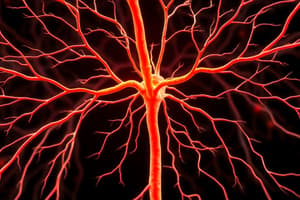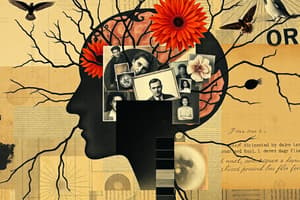Podcast
Questions and Answers
What is the difference between sensory input, integration, and motor output?
What is the difference between sensory input, integration, and motor output?
Sensory input detects stimuli and monitors the environment. Integration makes decisions based on sensory input and generates motor output. Motor output causes muscle contraction or gland secretion.
Which of the following is an example of somatic sensory?
Which of the following is an example of somatic sensory?
- Heart rate
- Hunger
- Stress
- Touch (correct)
What are the primary organs of the central nervous system (CNS)?
What are the primary organs of the central nervous system (CNS)?
- Cranial Nerves
- Brain (correct)
- Ganglia
- Spinal Cord (correct)
What organs belong to the peripheral nervous system (PNS)?
What organs belong to the peripheral nervous system (PNS)?
What is the ANS?
What is the ANS?
What are the divisions of the ANS?
What are the divisions of the ANS?
What is the difference between nuclei and ganglia?
What is the difference between nuclei and ganglia?
What is the difference between neuron and neuroglia?
What is the difference between neuron and neuroglia?
Neurons have a high ______ and do not ______ after birth.
Neurons have a high ______ and do not ______ after birth.
Which part of the neuron is responsible for receiving stimuli?
Which part of the neuron is responsible for receiving stimuli?
What is a synapse?
What is a synapse?
What are the parts of the reflex arc?
What are the parts of the reflex arc?
What makes the myelin sheath beneficial?
What makes the myelin sheath beneficial?
Match the following types of neurons with their functions:
Match the following types of neurons with their functions:
The gray matter of the CNS is located ______ and the white matter is located ______.
The gray matter of the CNS is located ______ and the white matter is located ______.
Which connective tissue surrounds each fascicle of a nerve?
Which connective tissue surrounds each fascicle of a nerve?
Flashcards are hidden until you start studying
Study Notes
Nervous System Basics
- Sensory input, integration, and motor output are the three main functions of the nervous system.
- Sensory input involves receiving information from the environment through sensory receptors.
- Integration involves processing and interpreting the sensory input, making decisions, and generating appropriate responses.
- Motor output involves sending signals to effectors (muscles or glands) to carry out the response.
- Afferent pathways carry sensory input to the CNS, while efferent pathways carry motor output from the CNS to the periphery.
The Nervous System: CNS & PNS
- The Central Nervous System (CNS) includes the brain and spinal cord, which are responsible for processing and integrating information.
- The Peripheral Nervous System (PNS) includes all the nerves outside the CNS, which carry sensory input to the CNS and motor output from the CNS.
- Cranial nerves connect the brain to sensory receptors and effectors in the head and neck.
- Spinal nerves connect the spinal cord to sensory receptors and effectors in the body.
- Ganglia are clusters of neuron cell bodies in the PNS.
- Nuclei are clusters of neuron cell bodies in the CNS.
The Autonomic Nervous System (ANS)
- The ANS controls involuntary actions such as heart rate, breathing, and digestion.
- The ANS has two divisions: the sympathetic nervous system (fight-or-flight response) and the parasympathetic nervous system (rest-and-digest response).
Neuron Structure & Function
- Neurons are the functional units of the nervous system, responsible for transmitting information.
- Neuroglia are supporting cells of the nervous system, providing structural support, nourishment, and insulation to neurons.
- Neurons are characterized by longevity, high metabolism, and an inability to divide after birth.
Neuron Components
- Neurons consist of a soma (cell body), dendrites, and an axon.
- The soma contains the nucleus and most of the cell's organelles.
- Dendrites receive signals from other neurons.
- The axon carries signals away from the soma.
- The axon hillock is the region where the axon arises from the soma and is also the site where action potentials are generated.
- The myelin sheath, made up of fatty substances, insulates the axon, speeding up signal transmission.
- Nodes of Ranvier are gaps in the myelin sheath that allow for faster signal transmission.
- The synaptic knob, also known as the axon terminal, stores and releases neurotransmitters.
Synapses
- A synapse is a junction between a neuron and another neuron, gland, or muscle cell.
- Synapses allow for communication between neurons.
- Neurotransmitters are chemical messengers that travel across the synaptic cleft, the space between two neurons.
- Axodendritic synapses occur between an axon and a dendrite, while axosomatic synapses occur between an axon and a soma.
Neuron Classification
- Multipolar neurons, the most common type, have one axon and multiple dendrites.
- Bipolar neurons have one axon and one dendrite.
- Unipolar neurons have one process that acts as both the axon and dendrite.
Functional Classification of Neurons
- Sensory neurons carry sensory information from the periphery to the CNS.
- Motor neurons carry motor commands from the CNS to muscles and glands.
- Interneurons connect sensory and motor neurons within the CNS.
Neuroglia
- Neuroglia are supporting cells that provide structural support, nourishment, and insulation to neurons.
- Astrocytes are star-shaped cells that provide structural support, regulate the blood-brain barrier, and help with neurotransmitter uptake.
- Microglia are small, phagocytic cells that engulf cellular debris and foreign substances.
- Ependymal cells line the cavities of the brain and spinal cord, helping to circulate cerebrospinal fluid.
- Oligodendrocytes are glial cells that wrap around axons in the CNS, forming the myelin sheath.
- Schwann cells are glial cells that wrap around axons in the PNS, forming the myelin sheath.
Myelin Sheath
- The myelin sheath insulates axons, increasing the speed of signal transmission.
- In the CNS, oligodendrocytes form the myelin sheath, while in the PNS, Schwann cells form the myelin sheath.
Gray and White Matter
- Gray matter in the CNS is composed of neuron cell bodies, dendrites, unmyelinated axons, and neuroglia.
- White matter in the CNS is composed of myelinated axons and neuroglia.
Nerves & Nerve Connective Tissues
- Nerves are cable-like organs in the PNS made up of bundles of axons.
- Nerve fibers are individual axons.
- Neurofibrils are bundles of neurofilaments that provide structural support for the axon.
- Nerves are made up of three connective tissue sheaths:
- Epineurium, which surrounds the entire nerve.
- Perineurium, which surrounds each fascicle (bundle of nerve fibers).
- Endoneurium, which surrounds each individual axon.
Reflex Arcs
-
A reflex arc is a neural pathway that involves the automatic response to a stimulus.
-
The reflex arc consists of five components:
- Receptor: Detects the stimulus.
- Sensory neuron: Carries the signal to the CNS.
- Integration center: Processes the information and generates a response.
- Motor neuron: Carries the signal from the CNS to the effector.
- Effector: Muscle or gland that carries out the response.
-
Monosynaptic reflexes involve a single synapse between the sensory neuron and the motor neuron, such as the knee-jerk reflex.
-
Polysynaptic reflexes involve multiple synapses between the sensory neuron, interneurons, and the motor neuron, such as the withdrawal reflex.
Studying That Suits You
Use AI to generate personalized quizzes and flashcards to suit your learning preferences.




